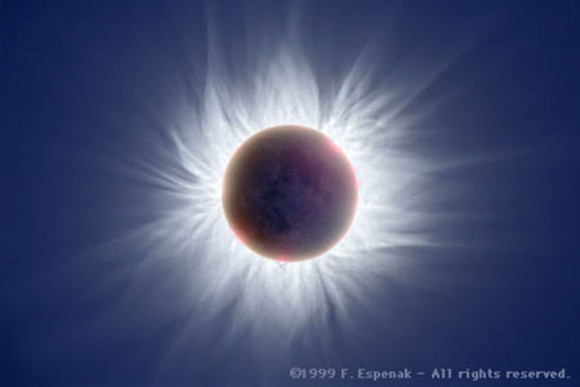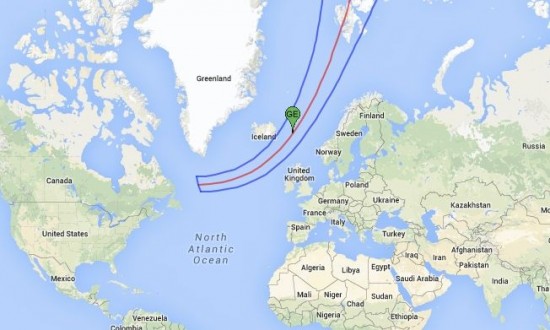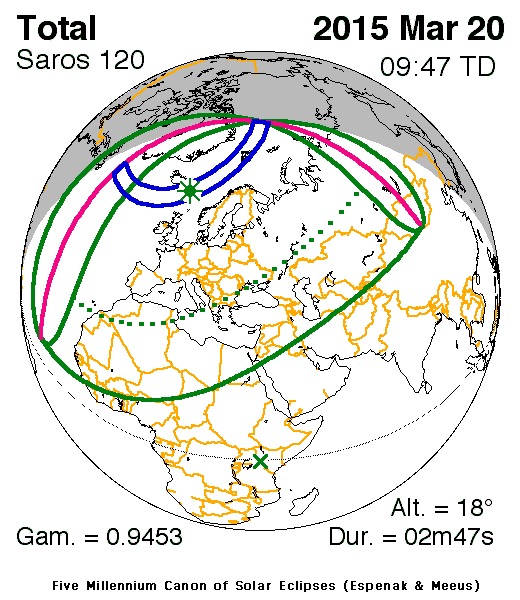A total solar eclipse is one of God’s grandest spectacle and this one tomorrow is linked to God's divine appointments, the Blood Moons (tetrad) and Shemitah. It is a warning to the world to repent and come back to God's Son Yeshua Hamaschiach or Jesus Christ. Notice the spacing of this solar eclipse to the Israeli election and seismic shift in Netanyahu's position towards the "Two State Solution".


Above, is the path of the solar eclipse tomorrow. There’s a
total eclipse of the sun coming up on Friday March 20, 2015 – the day of the vernal
equinox!
Does the vernal equinox and the solar
eclipse ‘just happen’ to occur on the same day? How often does this happen?
A total eclipse of the sun and the March equinox do fall on the same
date this year: March 20, 2015. The greatest eclipse occurs at 9:46 Universal Time, while the March equinox comes to pass some 13
hours later at 22:45 Universal Time.
The next solar eclipse at the March equinox will
happen on March 20, 2034. Then there will be two more in this century: 2053 and
2072.
Note the
spacing of 19 years between these four eclipses of the March equinox sun.
Does that
mean there are four solar eclipses coinciding with the March equinox every
century? No. If you know anything about astronomy, you might have guessed that
– here as in most sky-related phenomena – there are cycles acting within
cycles. Want to know more? Keep reading …
A solar
eclipse can only happen at new moon. For a solar eclipse to take place at the vernal
equinox, therefore, the new moon must come on the equinox date. Of course, a
March equinox new moon doesn’t always necessarily guarantee a solar eclipse. Here’s why.
New moons recur on (or near) the same
calendar dates every 19 years. This 19-year lunar period is known as the Metonic cycle. Amazingly, you can project this 19-year
cycle for centuries into the future (or past) to figure out when the new moon
will occur on the March equinox.
For example,
11 Metonic cycles equal 209 years (19 years x 11 = 209 years).
Therefore,
209 years after March 20, 2015, the new moon and the March equinox will both
take place on March 20, 2224. However, there won’t be a solar
eclipse on March 20, 2224! As we just mentioned … a new moon on
an equinox doesn’t guarantee an eclipse.

A total
solar eclipse can be seen only along a narrow pathway across Earth’s surface.
In the case of the March 20, 2015 eclipse that pathway cuts east of Iceland,
across the North Atlantic. Click here to learn more about the total eclipse.
From the
best of our reckoning, there will be no solar eclipses taking place on the
March equinox during the 22nd century (2101-2200) and 23rd century (2201-2300).
However, there is an eclipse cycle called the Gregoriana whereby we can also expect
the recurrence of a March equinox solar eclipse in a period of 372 years. It
happens because, in a cycle of 372 years, the phases of the moon recur on (or
near) the same weekdays and calendar dates. The eclipses (usually) fall on the
same dates as well.
Hence, the
next series of March equinox solar eclipses:
March 20, 2387: Partial solar eclipse
March 20, 2406: Total solar eclipse
March 20, 2425: Annular solar eclipse
March 19, 2444: Annular solar eclipse
March 20, 2463 Partial solar eclipse
March 20, 2406: Total solar eclipse
March 20, 2425: Annular solar eclipse
March 19, 2444: Annular solar eclipse
March 20, 2463 Partial solar eclipse
And the
previous series of March equinox solar eclipses:
March 19, 1624: Partial solar eclipse
March 20, 1643: Total solar eclipse
March 20, 1662: Total solar eclipse
March 20, 1681: Hybrid (Annular/Total) solar eclipse
March 20, 1643: Total solar eclipse
March 20, 1662: Total solar eclipse
March 20, 1681: Hybrid (Annular/Total) solar eclipse


No comments:
Post a Comment